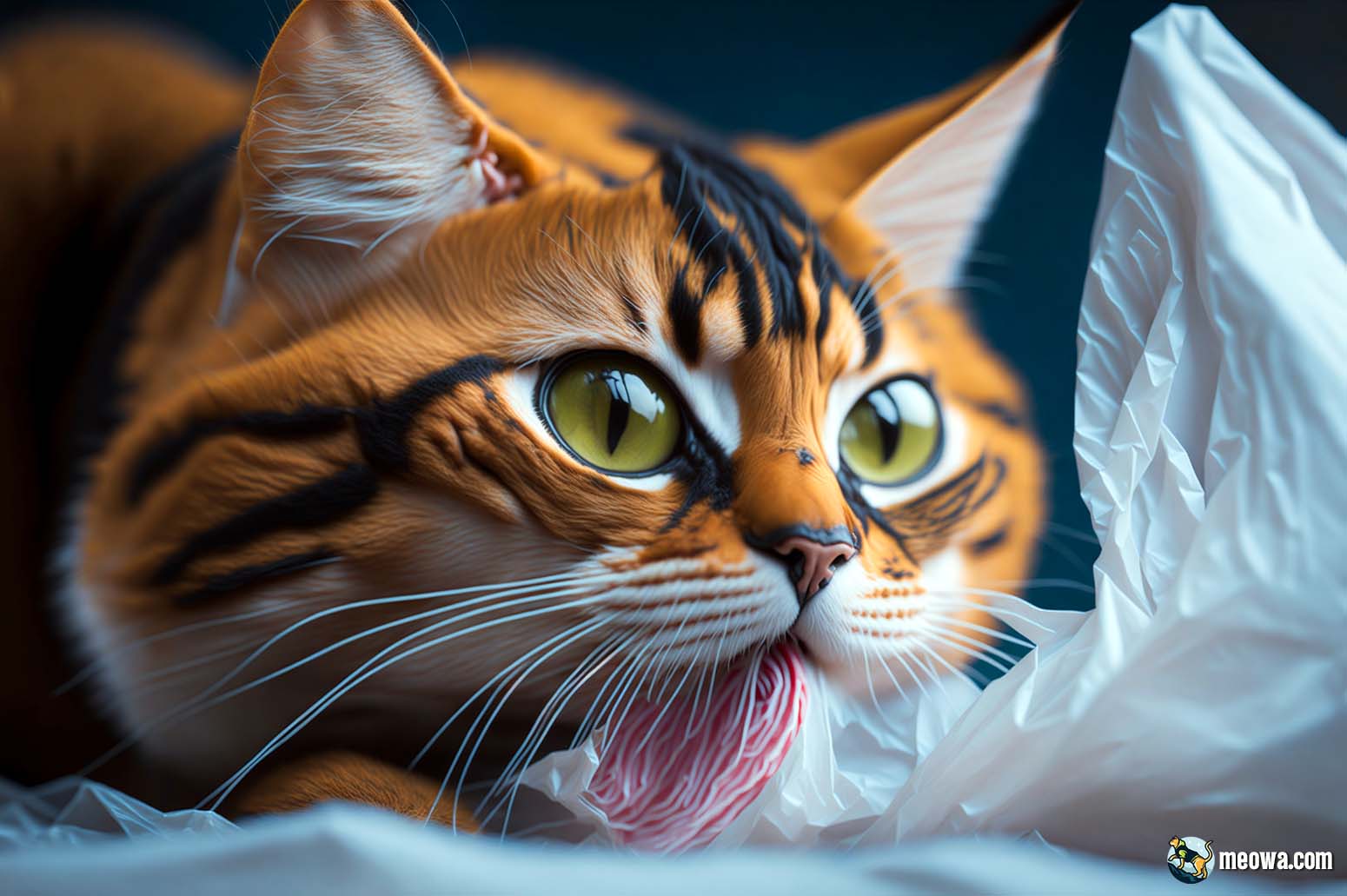Why Do Cats Like Plastic Bags: A Deep Dive into the Feline Obsession
We all know that the internet’s unofficial mascot is our beloved, quirky cats. From knocking things off tables to making biscuits on our bellies, cats often leave us scratching our heads and wondering, “Why on earth do they do that?” Among the most puzzling behaviors is their inexplicable love for plastic bags. You’ve probably found your cat rustling a grocery bag, gnawing on a sandwich wrapper, or even cuddling up with a bubble wrap. It’s as if these feline creatures have an unwritten rule: “See a plastic bag, must love it!”
So, Why Do Cats Like Plastic Bags?
Cats are drawn to plastic bags due to the enticing smells trapped in porous plastic, the crinkly noise which mimics the sounds of rodents, and certain chemicals used in plastic production. The smooth texture and the room temperature of the plastic can also be quite captivating for our feline friends.
Keen to dive deeper? Fear not, we’ll venture down the rabbit hole (or should I say, cat’s play tunnel?) to unveil the captivating science behind this behavior, discuss potential hazards, and offer tips on how to keep your curious kitty safe. Get ready for a purr-fectly enlightening journey.
The Magnetic Pull of Plastic: The Underlying Science
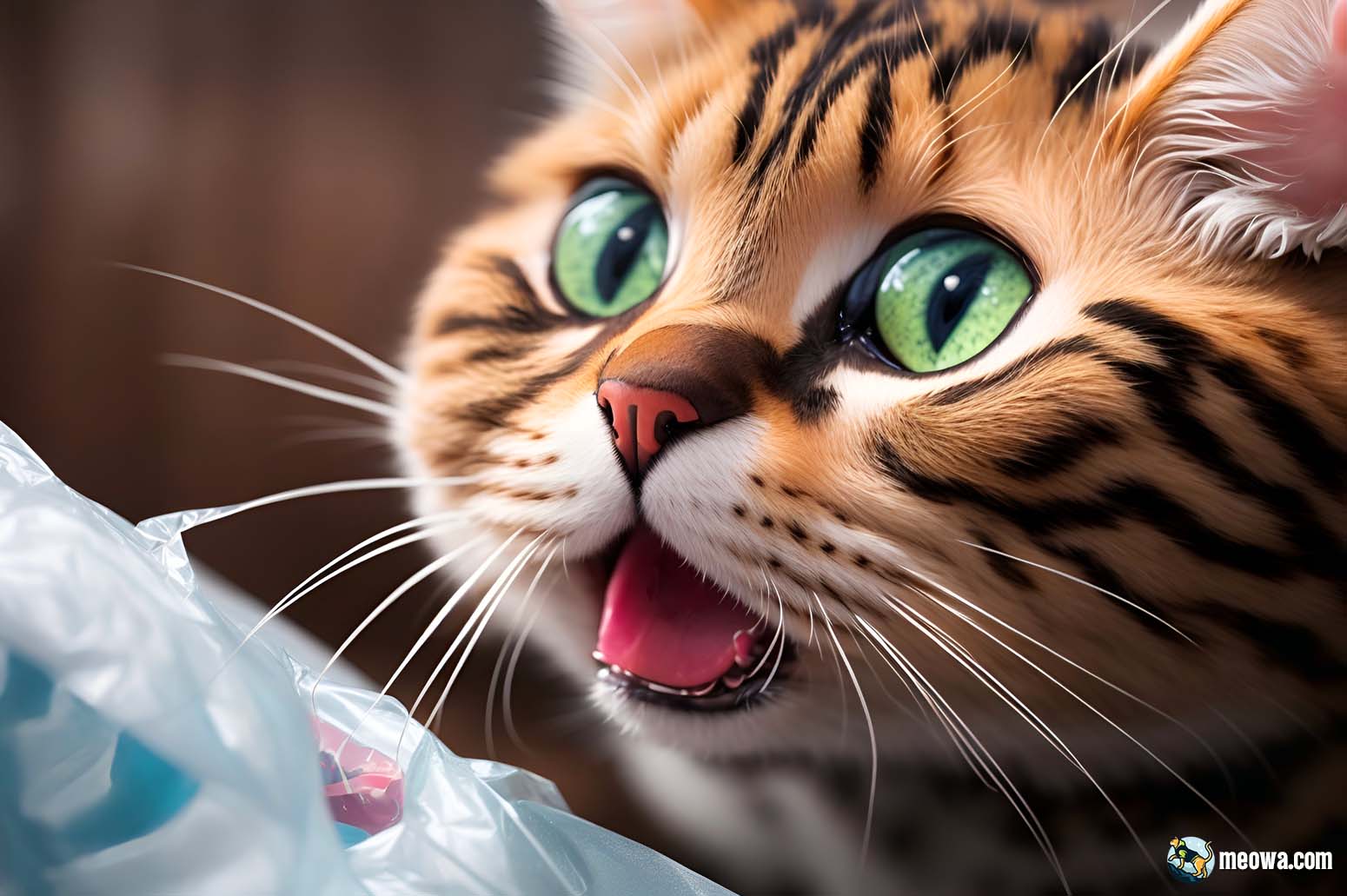
If you’ve ever looked at your beloved cat, happily snuggled into a plastic bag and thought, “Why, Whiskers, why?”, you’re not alone. Even the most seasoned cat owners find themselves asking the same question, “Why does my cat love plastic bags so much?” The truth is, it’s a fascinating mix of sensory appeals that make plastic bags a kitty magnet. Let’s unravel this feline mystery.
Smell- The Unsuspected Lure: Why Do Cats Like Plastic Bags’ Scent?
The answer lies partially in that nose of theirs. Cats have an extraordinary sense of smell – it’s 14 times stronger than humans’. We might sniff a plastic bag and pick up nothing but a faint synthetic odor, but for a cat, it’s a cornucopia of scents.
Consider this – plastic bags are made of polyethylene, a substance derived from petroleum products. Some cats might pick up the faint scent of hydrocarbons on the bags. Add to this the smorgasbord of scents the bag may have picked up at the grocery store, from food to cleaning products, and you’ve got a cat who’s ‘nose-over-tail’ in love with the intriguing smell of that plastic bag.
But what about other plastic objects, like toys or wrappers? Why does my cat chew on plastic items apart from bags? Well, some plastic items have a smell that’s similar to the pheromones in catnip. Your kitty isn’t crazy or weird for thinking that a plastic wrapper is a gourmet treat – it’s just following its nose!
Remember, this isn’t limited to just plastic bags. If you’ve ever caught your cat chewing on plastic wrappers, it’s for the same reason. It’s the smells!
It’s All About the Noise: The Crinkly Appeal of Plastic Bags
Moving from the intriguing smell, let’s shift our focus to another sensory delight plastic bags offer – the sound. Cats, being the alert and curious creatures they are, love exploring new sounds, and the crinkly noise plastic bags make is like sweet music to their feline ears.
Imagine this scenario: it’s a quiet afternoon, and suddenly the tranquility is shattered by the rustling sound of a plastic bag being blown by a breeze. Your feline friend, dozing in her favorite sunny spot, immediately perks up, her ears twitching. Within seconds, she’s darted across the room, pouncing on the crinkly culprit. It’s not just cute, it’s science. That rustling noise has engaged her primal hunting instincts, and she’s having a whale of a time!
Now, consider a case that most cat owners can relate to. Let’s talk about Miss Whiskers. Miss Whiskers is a five-year-old tabby with a penchant for plastic bags. Her human can’t comprehend it. “Why does my cat like to chew on plastic?” he wonders, watching as Miss Whiskers gently nibbles on the corner of a grocery bag. Every rustle sends her into a frenzy, her eyes wide and tail twitching in anticipation. It’s as if she’s engaging in a fierce battle with a worthy adversary, one that fights back with an enticing “crinkle-crinkle.”
The noise of a plastic bag mimics the sounds of small prey (think rodents scurrying through leaves). It’s part of the cat’s nature to be attracted to such noises, stimulating their predatory instincts.
With our newfound understanding, we see why our small feline hunters are irresistibly drawn to the crinkling sounds plastic bags produce. They show no bias – whether it’s a bag, a wrapper, or even your cherished book cover (whoops!). Their simple motto: if it crinkles, it’s delightful!
Digging Deeper: Uncovering Additional Reasons for Cats’ Plastic Fascination
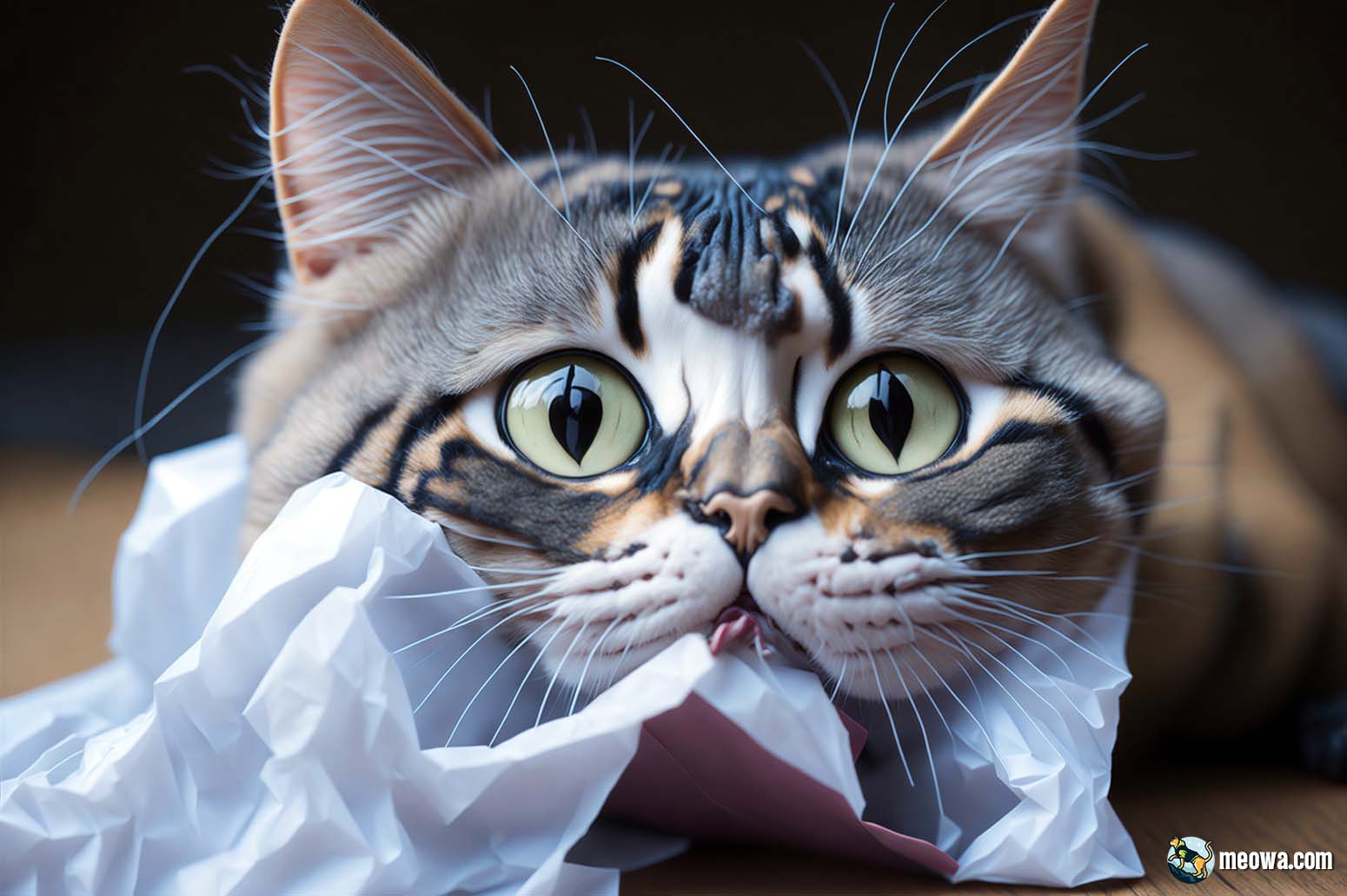
Unraveling the mysteries of feline behavior is no small task. As we delve further into our journey, let’s explore some intriguing theories that seek to explain the allure of plastic for our beloved fur-balls.
The Food Scent Appeal: An Olfactory Explanation
Cats’ noses are extraordinary. They’re like walking bloodhounds with whiskers. Their sense of smell is so strong that it could pick up the faint aroma of last week’s salmon dinner trapped in your plastic bag.
No wonder they’re always sniffing around in the most peculiar places! Picture this: a cat named Fluffy, who has an uncanny knack for sniffing out leftover food—even if it’s securely stashed away in a plastic bag.
The takeaway? Keeping your plastic bags cleaned and free from food remnants might just save you a midnight cat raid in the pantry.
The Sound of Fun: Plastic and Play
Picture a field mouse scurrying around in the underbrush. Now, substitute that rustling sound with the crinkle of a plastic bag. Cats, being the natural hunters they are, often associate this crinkly sound with prey. It’s like a wildlife symphony to their ears!
But, the game doesn’t have to involve plastic bags. Animal behaviorists suggest alternatives, like rustling toys, that can safely replicate this experience.
The Chemical Connection: Stearates, Pheromones, and Slip Agents
This one’s a bit of a science dive, but stay with us. Plastics often contain stearates, derived from tallow, and possibly even lanolin—the greasy stuff from sheep’s wool. To a curious kitty, these could be a gourmet scent invitation.
What’s more, many commercial shopping bags incorporate slip agents, compounds originating from stearic acid in animal fat. They’re frequently coated with various oils and lubricants like fish oil or beef fat, enticing your cat’s keen olfactory senses.
Then there’s the possibility that specific chemicals in these plastics might mimic pheromones. This can provoke what’s known as the flehmen response, a behavior in which a cat sniffs something intensely, then lifts its head and appears to grimace.
Our advice? Regularly switch out plastic bags for safer alternatives and avoid unintentionally triggering a feline chemistry experiment.
The Biodegradable Draw: Corn Starch Factor
In our quest for eco-friendliness, we’re seeing more biodegradable plastics. These often contain corn starch—an ingredient that seems to drive some cats wild. But wait, don’t we associate corn with farm animals and popcorn, not cats?
Turns out, Fluffy might be more adventurous with her palate than we thought. On a serious note, understanding the composition of items your cats interact with can give you a leg up in managing their behaviors.
The Comfort of Texture and Temperature
Cats are renowned for their love of comfort. Smooth surfaces? Check. Warm places? Double check. Now, imagine a material that’s smooth and quickly matches room temperature—like plastic.
It’s almost like we’ve discovered the recipe for a cat’s favorite lounging spot! It may seem like an episode of “Extreme Cat Comforts,” but understanding these peculiarities can help create safer, equally appealing options for our feline friends.
The Psychology of Pica: Understanding the Compulsion
Pica—the urge to eat non-food items—can sometimes be an issue in cats. It’s like your feline companion suddenly decided to go on the weirdest diet ever.
Some theorize it could be due to dietary deficiencies, others see it as a compulsion. Either way, it’s a good reason to keep plastic out of paws’ reach and to have a chat with your vet if you notice this behavior.
Intriguingly, some cats develop an unusual habit called ‘wool sucking’. This compulsion, potentially linked to early weaning or stress, involves texture-oriented licking and can extend to materials like plastic. For a deeper dive into ‘wool sucking’, check out this insightful article.
Siamese, Birman cats and their kin often exhibit wool sucking, which typically emerges around one year of age. Like Pica, it’s crucial to consult your vet if your cat shows such tendencies, ensuring your feline friend’s well-being.
The Boredom Factor: A Cry for Enrichment
Sometimes, the answer is simpler than we think. Cats might engage with plastic bags out of sheer boredom! Maybe your kitty is just yearning for a bit more excitement in their life.
Enrichment is key in a cat’s life. It keeps them mentally stimulated and physically active. Swap out the plastic bags with interactive toys, climbing trees, or puzzle feeders. Who knows? Your cat might just become the next feline Einstein!
In the grand theater of feline eccentricities, plastic bag infatuation might claim the spotlight, but it’s not destined for a permanent run. Grasping the motivations and devising strategies to counter them can pave the way for a safe, joyful, and plastic-free habitat for our cat stars. Keep exploring, cat enthusiasts!
It’s Not Just Bags! Cats and Their Universal Love for Plastic
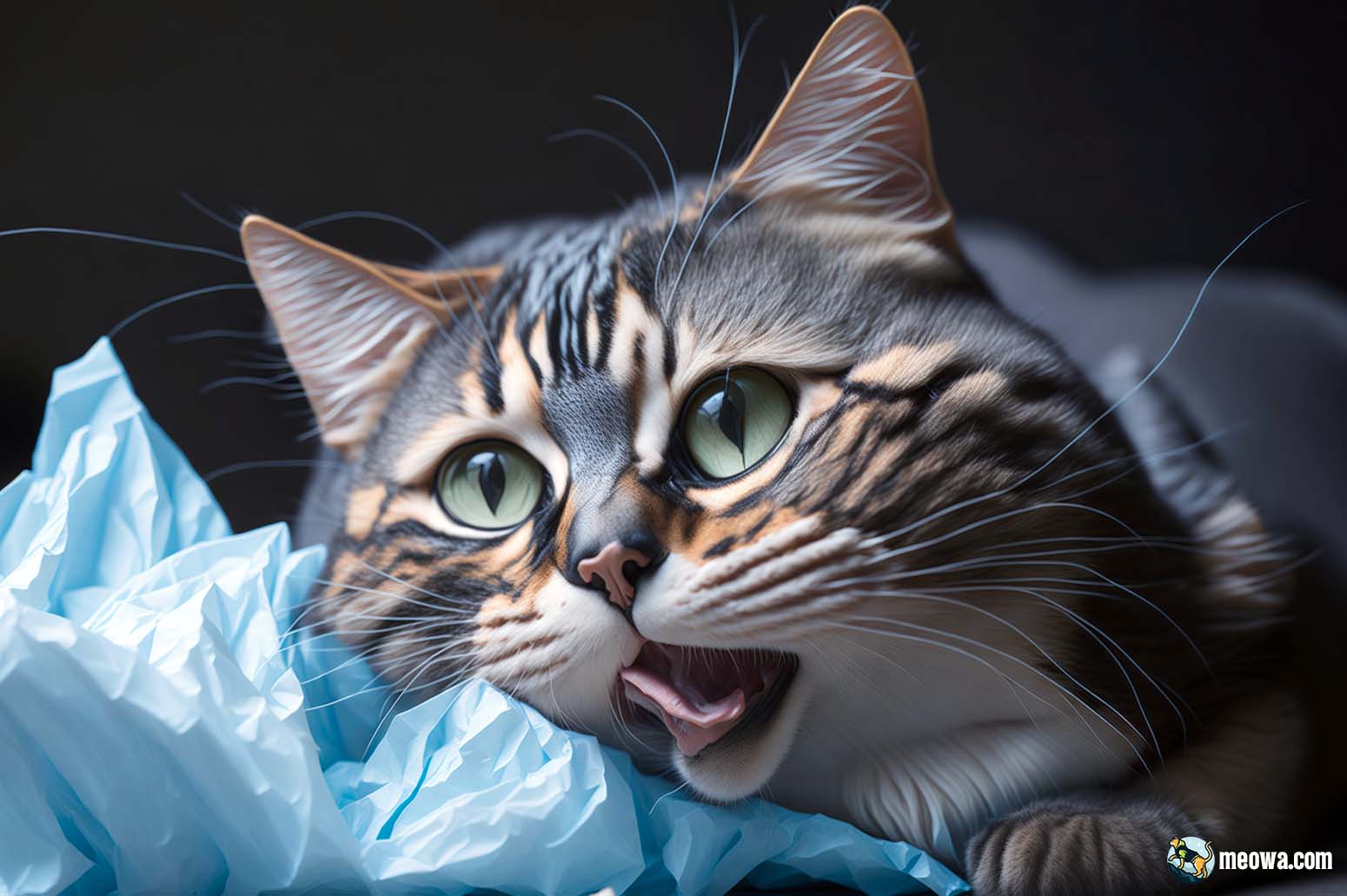
The plot thickens as we venture into the larger realm of plastic love. It’s not just plastic bags, but cats seem to have a sort of universal love for everything plastic. Our feline friends don’t discriminate among different forms of plastic, be it the unassuming plastic bags, the mischievous plastic bottle caps, or the enigmatic plastic wrappers. Their love knows no bounds, and their fascination seems to increase with every new plastic item they encounter.
When Plastic Toys Become Catnip: Cats’ Attraction Towards Plastic Objects
When it comes to plastic objects, there’s a whole universe out there for our cats to explore. Plastic straws, plastic bottle caps, and yes, even those pesky plastic wrappers that you accidentally drop on the floor. It seems like our furry friends can’t help but be drawn to these tantalizingly shiny, crinkly objects.
But why do cats chew on plastic, or why do cats lick plastic, you might ask? The explanation might lie in the texture and the intriguing noises these objects produce. Plus, who can resist a plastic straw that rolls erratically, much like a scurrying mouse, or a bottle cap that spins like a dizzy beetle when swatted? It’s all a game to them, a delightful diversion that’s endlessly entertaining.
Let me share an amusing little story about a cat named Shadow. Shadow, like most cats, had a thing for plastic. But his affection was not limited to just bags or wrappers. Oh no, he was more adventurous. Shadow had a special bond with – wait for it – plastic straws!
His human would often wake up to a trail of straws leading from the kitchen to Shadow’s favorite spot under the dining table. The straws were his prized possessions, his trophies of a successful night of hunting in the wild kitchen terrain. “Why does my cat eat plastic?” his human often wondered, watching Shadow gently gnaw on a straw. It was a mystery, a puzzle that added to Shadow’s enigmatic charm.
Just remember, while it’s amusing to see our feline companions’ antics with plastic items, we need to ensure their safety. So, while they’re having fun, keep an eye on them to ensure they don’t swallow any bits of plastic in their play, leading to a “my cat ate plastic and is throwing up” situation!
When Love Turns Risky: Health Risks and Safety Concerns of Cats Eating Plastic
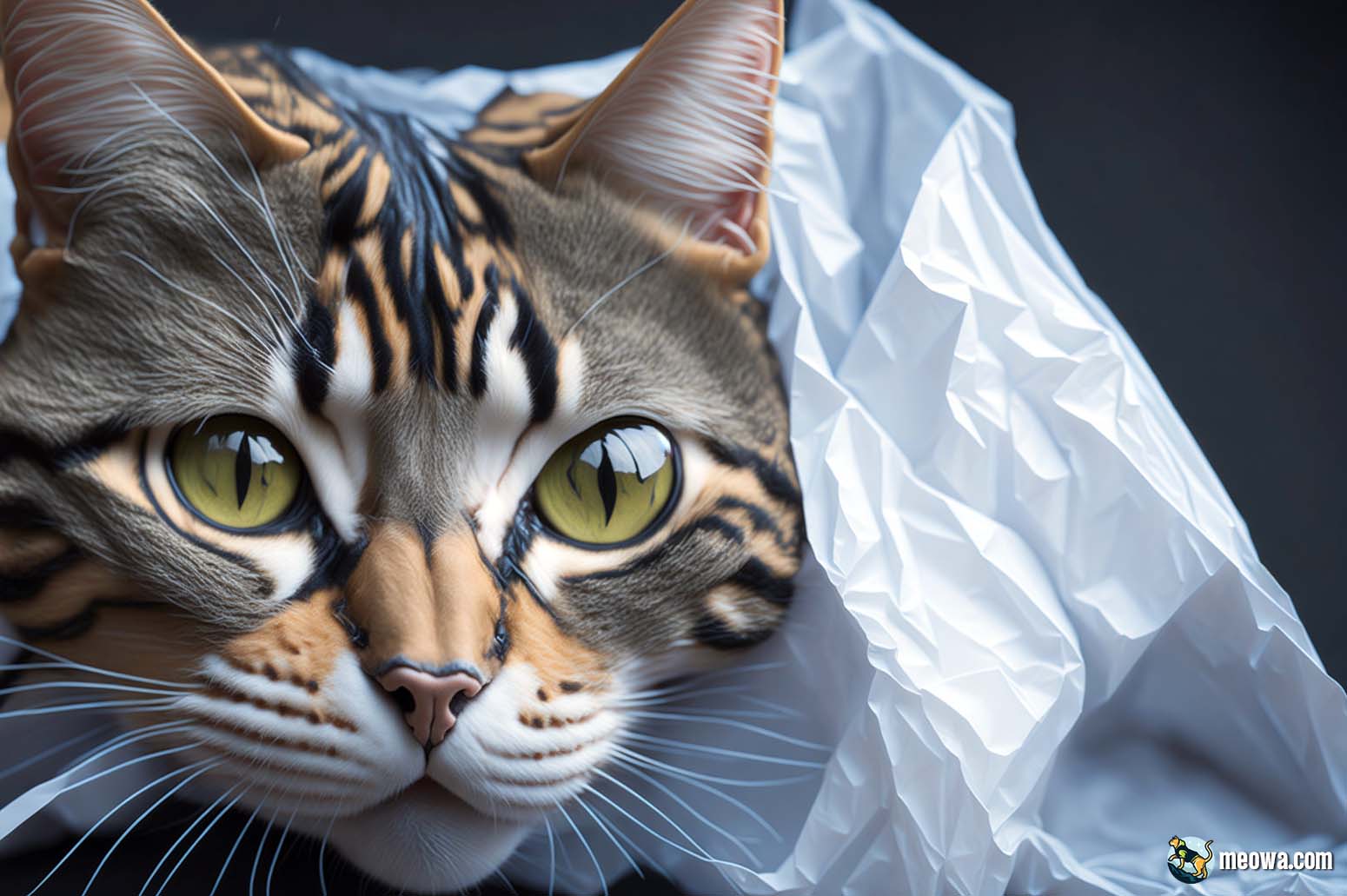
While it’s all fun and games to watch our feline friends’ fascination with plastic, it’s also important to remember the potential dangers that lurk behind this seemingly harmless playtime. Yes, we’re venturing into a slightly more serious territory now. Our main concern, as responsible cat parents, should be: Are cats eating plastic bags harmful? Let’s discuss this and more.
Perils of Plastic: The Health Hazards of Cats Eating Plastic Bags
Cats and plastic bags can be a risky combination. While their attraction to these shiny, crinkly objects is unquestionable, it’s equally undeniable that these seemingly innocuous items can pose some serious health hazards if ingested.
Let’s take a moment to consider the biological makeup of our feline friends. Cats, much like their lion and tiger cousins, are obligate carnivores. This means their bodies are designed to process meat, not plastic. When a cat eats plastic, it can lead to a multitude of problems ranging from choking hazards, to digestive blockages, to toxicity from certain plastics. Ingesting plastic is definitely bad for cats and can lead to serious health complications.
To illustrate this, let’s talk about Whiskers, a frisky little tabby with a penchant for plastic. One day, his human noticed that he wasn’t his usual playful self. Whiskers seemed lethargic, had lost his appetite, and worst of all, his human noticed he was having trouble using his litter box. After a rushed trip to the vet, it was revealed that Whiskers had eaten a piece of plastic that had lodged in his intestines. The poor thing needed surgery to remove the blockage. Luckily, Whiskers made a full recovery, but it was a scary reminder of the risks of cats eating plastic.
Is My Cat Eating Plastic? Signs to Watch Out For
Now that we know the potential dangers, it’s crucial to identify signs that your cat might be eating plastic. If you’ve found yourself wondering, “How do I know if my cat ate plastic bag?”, here’s some expert advice to help you identify and handle such situations.
Some signs that your cat might have ingested plastic include:
| Signs Your Cat May Have Eaten Plastic | Potential Outcomes | Immediate Actions |
|---|---|---|
| Changes in appetite or weight loss | Could indicate a blockage in the digestive tract | Monitor eating habits, check for plastic items in cat’s vicinity |
| Vomiting or diarrhea | Might be the body’s attempt to expel the ingested plastic | Ensure cat stays hydrated, remove any visible plastic pieces |
| Unusual lethargy or lack of activity | Suggests general discomfort or illness due to ingestion | Keep cat comfortable, monitor behavior closely |
| Difficulty using the litter box or changes in their stool | Possible blockage or discomfort in the intestines | Check stool for plastic remnants, ensure litter box is clean |
| Unexplained coughing or gagging | Could suggest choking or irritation in the throat | Check mouth and throat if safe, remove any visible plastic |
Note: All these symptoms warrant immediate veterinary attention. While these actions can be taken, they are not a substitute for professional veterinary care. The sooner your cat gets professional help, the better its chances for a complete recovery. If you notice any of these signs and suspect that your cat has eaten plastic, seek veterinary care immediately. Remember, it’s always better to be safe than sorry.
In the next section, we’ll look into preventive measures and alternatives to keep our feline friends safe while satisfying their penchant for plastic. But for now, let’s pause for a moment and let this information sink in.
Nipping the Plastic Habit in the Bud: How to Stop Your Cat from Chewing Plastic Bags
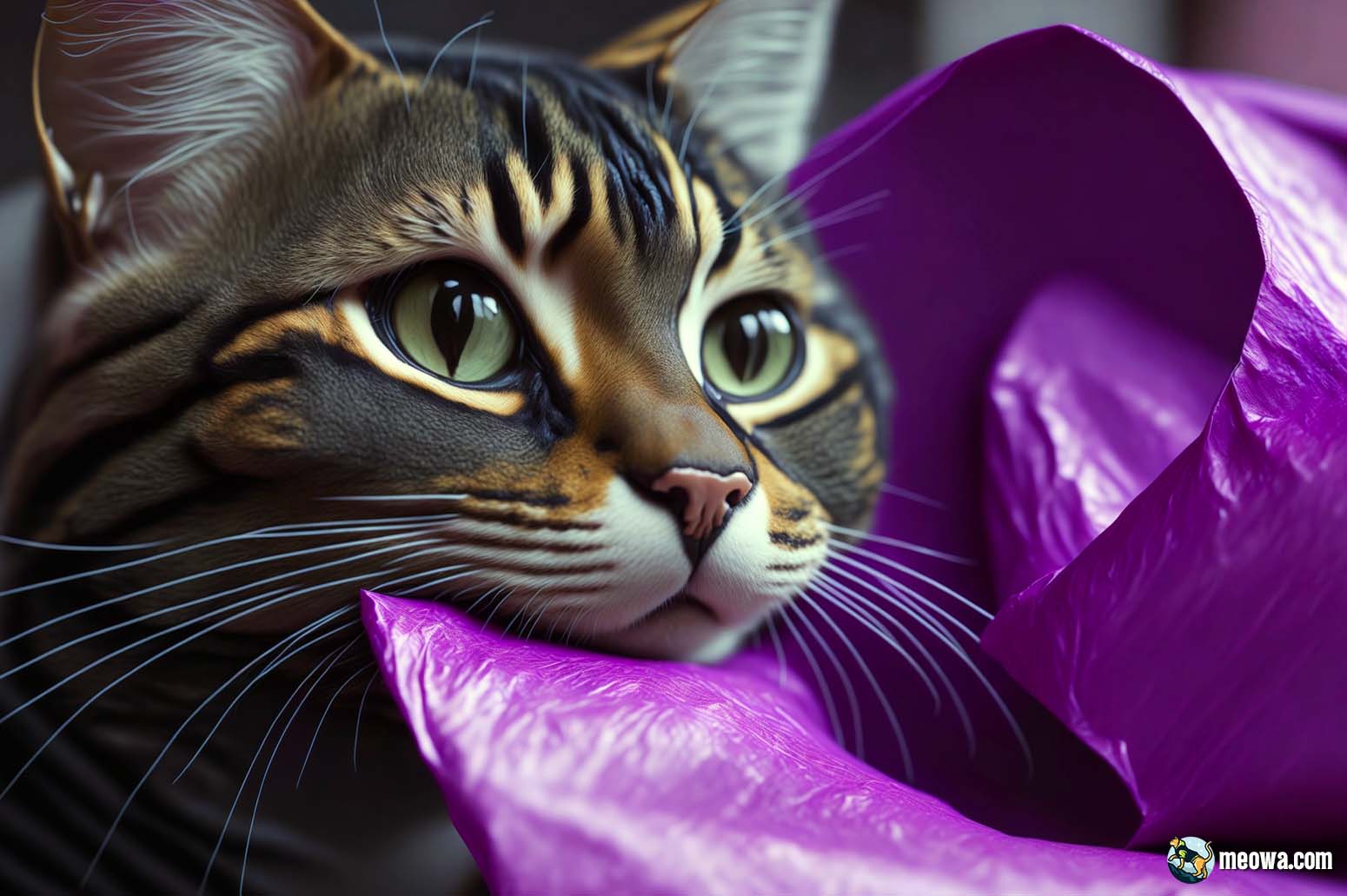
All cat parents will attest, their fur babies have their own quirks that are often endearing and sometimes baffling. One such curiosity is their fondness for plastic bags. However, when these peculiarities risk their well-being, we need to step in. If your kitty can’t resist the lure of plastic, here’s how to redirect their interest to safer options.
From Plastic Bags to Safe Alternatives: Transitioning Your Cat’s Chewing Habit
Redirecting your cat’s love for plastic to safer alternatives requires patience, a pinch of creativity, and a dollop of love. Here are some comprehensive and tried-and-tested strategies.
Interactive Cat Toys
Interactive cat toys are an absolute hit with felines and could be a life-saver when trying to shift their focus from plastic.
- Why They Work: Interactive toys pique a cat’s interest, keeping them engaged for hours. A few toys even have crinkly materials inside that closely mimic the sound of plastic bags.
- How to Use Them: Introduce your cat to various toys and closely observe their reaction. Does your cat love chasing things around? A ball might be your best bet. Do they love to pounce? Consider a toy mouse.
Cardboard Boxes
Never underestimate the allure of a good old cardboard box.
- Why They Work: Boxes provide a great sense of security to cats. They love the cozy corners and the dark, mysterious interiors. This can make boxes a strong contender against plastic bags.
- How to Use Them: Simply keep a few sturdy boxes around your home. For added fun, consider creating multi-story box towers or labyrinth-like structures!
Paper Bags
If your cat enjoys exploring plastic bags, they might take a liking to paper bags as well.
- Why They Work: Like cardboard boxes, paper bags provide a private space where cats can hide and relax. Plus, they make similar rustling noises as plastic bags when moved.
- How to Use Them: Leave a few open paper bags (with handles removed for safety) around your living space. Watch as your cat takes an investigative leap into these harmless hideouts!
Cat Trees or Scratching Posts
For the feisty feline with a plastic-chewing habit, cat trees and scratching posts can provide an engaging distraction.
- Why They Work: They cater to a cat’s natural instinct to climb and scratch, diverting their attention from plastic bags.
- How to Use Them: Find a cat tree or a scratching post that’s tall and sturdy enough for your cat’s size. Place it in a location where your cat usually spends time.
Edible Grass or Catnip
Finally, edible cat grass or catnip can also help divert your cat’s chewing habits.
- Why They Work: These plants not only provide a safe and enjoyable chewing experience but also aid in their digestive process.
- How to Use Them: You can buy cat grass or catnip from pet stores, or even grow them at home. Some cats love them so much they might forget about plastic bags altogether!
Chew Toys
Chew toys can be another great alternative for cats prone to chewing on plastic bags.
- Why They Work: These toys satisfy a cat’s desire to chew and gnaw, providing a much safer outlet for this behavior than plastic bags.
- How to Use Them: Introduce a variety of chew toys and see which ones your cat prefers. Some cats might enjoy soft plush toys, while others might prefer harder rubbery textures. Remember to replace chew toys regularly to ensure they stay hygienic and safe for your cat.
Spring Toys
Don’t forget about spring toys, another favorite among many cats.
- Why They Work: Spring toys are fun to bat around and chase, keeping cats physically active and mentally stimulated, which can distract them from chewing on plastic.
- How to Use Them: Scatter some around the house in areas where your cat likes to play. Watch as your cat bats these toys with delight!
Comparison Table
To make the decision process easier, here’s a comparison table summarizing each alternative:
| Alternative | Why It Works | How to Use |
|---|---|---|
| Interactive Toys | Mimics sound and keeps cat engaged | Try various toys, observe cat’s preference |
| Cardboard Boxes | Provides security, similar rustling sound | Keep boxes around home, create structures |
| Paper Bags | Similar rustling sound, provides hiding space | Leave open bags around living space |
| Cat Trees/Scratching Posts | Satisfies climbing and scratching instincts | Place in cat’s favorite location |
| Edible Grass/Catnip | Safe to chew, aids digestion | Buy or grow, introduce to cat |
| Chew Toys | Satisfies chewing instinct | Introduce variety, observe cat’s preference |
| Spring Toys | Stimulates physically and mentally | Scatter around play areas |
A real-life success story can be motivating in this endeavor. Miss Whiskers, a charming white Persian, was notorious for her plastic chewing habit. Her anxious parents decided to slowly introduce her to interactive cat toys and catnip. They swapped her favorite plastic bags with crinkly toys and sprinkled catnip on them. It was a slow start, but patience paid off. Now, Miss Whiskers is obsessed with her feathered catnip toy, and the plastic bags are safely tucked away.
Remember, each cat is unique, and what works for one may not work for another. It might take some trial and error to find the best alternative for your kitty. The goal is to keep your pet safe and satisfied, while gradually eliminating their interest in plastic bags.
Conclusion: Understanding and Addressing Your Cat’s Plastic Fascination
We’ve arrived at the end of our intriguing journey, exploring why cats are so infatuated with plastic bags. This seemingly strange fascination can be attributed to an exciting blend of sensory experiences: the crinkling sounds, the unique scent, and the joy of touch. However, as amusing as these antics can be, there are undeniable risks involved.
Across this comprehensive guide, we’ve dissected the science behind the feline attraction to plastic. We’ve also delved into the hazards associated with this habit, such as the possibility of ingestion leading to health issues.
Strategies for breaking the plastic-chewing habit and introducing safer alternatives were also shared. Since each cat is unique, finding the ideal substitute might involve some experimentation. But, the ultimate goal remains the same: ensuring the safety and contentment of our feline friends.
There’s no denying that our cats, with their peculiar habits and mysterious allure, bring boundless joy and laughter into our lives. As we decipher these behaviors, our bond with these fascinating creatures deepens.
Lastly, we’d love to hear from you! Do you have any amusing stories or experiences related to your cats and plastic bags? Have you found effective strategies for managing this behavior? Share your thoughts in the comments below.
If you’re keen on unraveling more feline behaviors, check out our other articles. Your feedback is always welcome, especially if there’s a specific topic you’d like us to address in a future post.
Here’s to enjoying and cherishing every moment with our cats, from their playful chases after plastic bags to their peaceful naps in our laps. Happy cat parenting!

